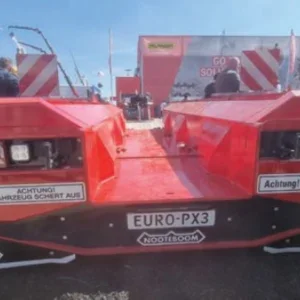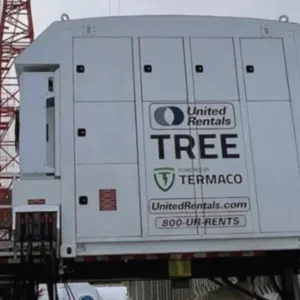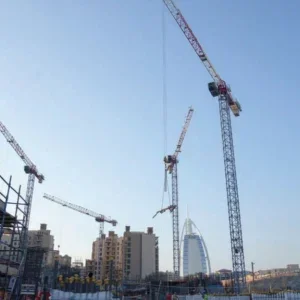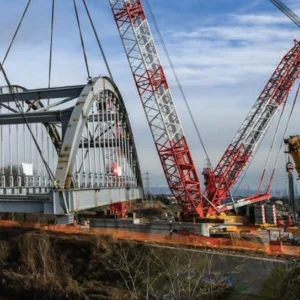According to a recent report by the Raleigh, North Carolina-based construction consulting firm FMI Corporation, the US construction boom continues to impact crane manufacturers and rental houses alike—especially in Manhattan where the call for crawler cranes and operators is reaching critical mass.

Bay’s Liebherr LR 1200 erecting structural steel for a new ice skating rink on the grounds of the former Worlds fair in Flushing, New York.
FMI construction economist Heather Jones says that building in Manhattan is in an all time high that’s anticipated to last through 2011.
“For non-residential construction in Manhattan, we’re looking at 9%–11% growth between now and 2011,” she says. “Residential is taking a little hit in ‘07 but we anticipate it will ramp up again in ‘08,” she says, although this data does not include new housing starts. The increase, Jones says, is due to many factors including the cost of materials, labour and square footage. “You’re building more, then it’s going to cost you more.” Additionally, the market expects to face labour challenges to find and retain skilled workers.
With construction booming all over Manhattan, rental houses are feeling the pinch. “It’s only March and we’ve committed almost our entire fleet—12 cranes—for the next nine months,” says Manny Zaccone, sales manager of Cranes, Inc., Queens. “Right now, there’s a tremendous call for crawlers, especially 300 US ton or larger cranes.”
Zaccone says that the amount of high-rise construction is increasing the demand for crawlers. Zaccone also points out that crawlers are more in demand for long-term projects, such as the Freedom Tower project, compared to hydraulic cranes that are used for more short-term projects—usually a month or less.

A Liebherr LR 1400 equipped with 92ft main boom and 92ft luffing jib
erecting a precast parking garage in Queens, New York
Kenneth Bernardo, president and chief operations officer of Bay Crane Services, Inc., with offices in Long Island City and Hicksville, New York, also says that demand is high in the area.
The call has been so intense that Cranes, Inc. is in the market for additional machines to supplement its fleet. The company has already added ten machines this year and is on the lookout for more.
The challenge, Zaccone says, is availability. “Right now, we’re looking to buy new or used machines, but we’re finding the wait time on new machines too long,” he says. “We’re also looking at bringing in machines from other parts of the country if necessary in order to meet our customers’ demands.”
While Cranes, Inc., only has offices in Queens, they do send machines all over the country—Manhattan not withstanding. “We’ve sent ‘em as far north as Canada, as far south as the Carolinas and as far west as Wisconsin,” he says.
While finding machines can be problematic, other options are becoming available. For example, United Rentals, a US equipment rental company, recently started auctioning machines on eBay. With scissor lifts and booms now available for auction online, cranes won’t be far behind.
Along with the increased call for machines comes the increased call for operators. Cranes, Inc. also supplies operators to its customers, courtesy of Locals 14 and 15 of the International Union of Operating Engineers. “Manpower is getting a little tight,” Zaccone says. “Our customers usually call for operators. We have 30 to 35 operators right now that we use and they’re all specially trained, experienced and qualified to operate Liebherr equipment.”
Cranes, Inc. specialises in late model machines, none older than five years and nearly all of them Liebherrs. “We offer Liebherr’s LR100 on the small end all the way up to their LR1400/2,” Zaccone says. “We’re thrilled with Liebherr products, its factory support, that’s why it continues to get our business. In fact, in 1996, our company was the first to purchase, and then use, a Liebherr in New York City.”
While this might sound like good news for Liebherr, according to Scott Moreland, Liebherr Nenzing VP of sales for the United States, the last thing any manufacturer (or rental house) wants to tell a customer is they’re out of product—or backlogged. “We are of course, well aware of the boom in Manhattan and in a way this is the perfect storm.”
Bernardo says that he is cautiously optimistic that Bay will be able to meet the current demand. But he voices a note of concern about what happens after the storm. “With the large number of cranes delivered and added to the market in the last few years, we see the potential long-term threat of supply once again exceeding demand as it has done in the past,” he says.
Moreland says that Nenzing’s order backlog currently extends into late 2007 because of problems getting components. “We’re experiencing a real challenge getting steel,” Moreland says. With the increased construction taking place in China, the steel shortage doesn’t seem to be improving.
Indeed, according to the FMI report, in addition to steel, there will be pressures to bring other components to the market, including cement, copper and diesel fuel, that are projected to delay projects and escalate costs.
Labour is likely to be another issue. According to the FMI report, as the American Baby Boom Generation (those born approximately between 1945-1964) retires out of the marketplace, it will leave an employment shortfall that will not only put a strain on the crane market, but is expected to affect the entire American workforce. The report states companies that focus on recruitment, training and retention will likely possess a competitive advantage in the ongoing battle for talent.
Relative to the rest of the US, FMI estimates that growth for non-residential construction markets may reach as high as 9% overall and that almost all sectors, with the exception of religious buildings, will be well ahead of the growth rate for the economy gross domestic product (GDP) in 2007. Furthermore, even though many geographic locations in the states are suffering from a housing bubble burst, the dearth of new housing sales will not adversely affect the market since many of those workers may switch over from residential to commercial construction projects.
Jones says the residential market will decrease by 14% then will kick back into high gear from 2008-2011. In 2006, non-residential building outpaced residential building for the first time since 1997 and residential construction is not expected to outpace non-residential construction until after 2008.
High-profile New York City projects are drawing crawler cranes.
World Trade Center rebuild. Construction consists of the Freedom Tower, WTC office towers 2, 3 and 4, the WTC Transportation Hub, a memorial and a memorial museum. All buildings are expectProject file A Liebherr LR 1400 equipped with 92ft main boom and 92ft luffing jib
erecting a precast parking garage in Queens, New York Queens crawler Bay’s Liebherr LR 1200 erecting structural steel for a new ice skating rink on the grounds of the former Worlds fair in Flushing, New York.
Bay crawler






